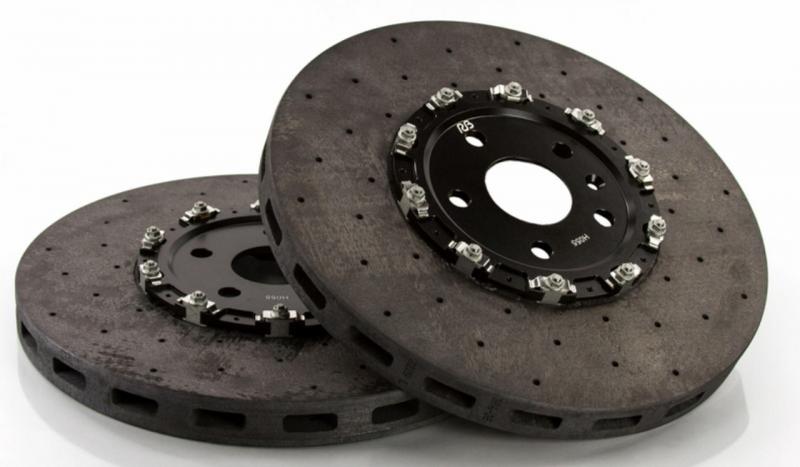Automotive braking technology has come a long way from conventional drum brakes to sophisticated carbon-ceramic brakes. Carbon-ceramic brakes have emerged as a revolutionary brake material that offers superior braking performance compared to traditional brake materials. Though more expensive than conventional brakes, carbon-ceramic brakes are becoming increasingly popular in high-performance vehicles due to their unmatched durability and response. This article discusses the key aspects of carbon-ceramic brakes and their advantages over other brake systems.
What are Carbon-Ceramic Brakes?
Carbon-ceramic brakes, also known as carbon-ceramic matrix (CCM) brakes, use a composite material made from carbon fiber reinforced silicon carbide for the friction material. The carbon fibers provide strength and stiffness, while silicon carbide contributes hardness, thermal conductivity, and wear resistance. The carbon-ceramic discs are typically 15-20 mm thick made through a sintering process at ultra-high temperatures. They are significantly lighter yet stronger than cast-iron brakes with a melting point more than double that of regular brake pads.
Some key features of carbon-ceramic braking systems include monolithic or clamped multi-piece brake discs, high-friction carbon pads, and multi-piston aluminum calipers. Leading brake manufacturers like Brembo, AP Racing, and Akebono offers carbon-ceramic brakes designed to withstand extreme heat and tremendous braking force generation capabilities. Top-end vehicles like Ferrari, Lamborghini, McLaren, etc. come equipped with prominent carbon-ceramic brake calipers and rotors as standard fitment.
Advantages of Carbon-Ceramic Brakes
Weight Savings: Carbon-ceramic brakes are significantly lighter than cast-iron or steel brakes, resulting in unsprung weight savings. This enhances acceleration, braking, handling, and fuel efficiency. Typical weight savings are around 50% compared to cast-iron brakes.
Superior Heat Dissipation: Due to their material composition, carbon-ceramic brakes can withstand extreme heat of over 3000°F during periods of heavy braking without fading. Their thermal conductivity is better than any other brake material, ensuring consistent braking performance lap after lap.
Reduced Brake Dust: Carbon-ceramic rotors produce minimal brake dust as they do not glaze or score under heavy braking. This keeps brake components cleaner for long-term maintenance.
Improved Pedal Feel: Carbon-ceramic brakes deliver an immediate, progressive, and linear braking response. The feedback through the brake pedal is much improved giving drivers excellent feel and control.
Enhanced Durability: The carbon-ceramic material is extremely durable and resistant to wear even under the most punishing track conditions. Properly maintained carbon-ceramic brakes can reportedly last over 50,000 miles.
Value Over the Long Run: Though very expensive upfront, carbon-ceramic brakes might prove more cost-effective in the long run due to their longevity and reduced need for replacement and maintenance.
Limitations of Carbon-Ceramic Brakes
Some minor limitations of carbon-ceramic braking components include:
High Initial Cost: Carbon-ceramic brake systems are significantly pricier to purchase than conventional brakes. An average set of CCM brakes costs upwards of $25,000 retrofitted on a sports car.
Susceptible to Damage: Carbon-ceramic rotors can develop hairline cracks if subjected to curb impacts. Proper handling is required to avoid rotor damage under accidental impacts.
Noise Characteristics: Carbon-ceramic brakes produce a high pitched squealing noise under light braking, which may unnerve some drivers initially accustomed to less noisy brakes.
Difficult Repair/Replaceability: Damaged CCM components usually cannot be repaired and need complete replacement. Rotors cannot be turned like cast-iron rotors once worn.
Applications of Carbon-Ceramic Brakes
Considering their strength, thermal conductivity, and durability, carbon-ceramic brakes are increasingly favored in high-performance applications that demand extreme brake performance and fade resistance. Some common applications include:
- Super/Hyper cars: Virtually all supercars and hypercars from Ferrari, Lamborghini, McLaren, etc. use carbon-ceramic brakes as standard.
- Race cars: All open-wheel and sports prototype race cars competing in F1, Le Mans, GT series, etc. use carbon-ceramic brake components for track usage.
- Luxury/Sports cars: Many luxury/performance vehicles from BMW, Mercedes, Audi, Nissan, offer carbon-ceramic brakes optionally or as part of track packages.
- Off-road vehicles: Pro off-road trucks and monster trucks competing in Baja and Dakar events prefer CCM brakes for heat resistance.
- Electric vehicles: EVs put extensive load on brakes due to regenerative braking. Hence high-performance EVs also adopt carbon-ceramic braking systems.
Future of Carbon-Ceramic Brakes
With continual refinements in material composition and manufacturing processes, the advantages of Automotive Carbon Ceramic Brakes are expected to be leveraged further across more vehicle classes. Advancements like new matrix designs to improve durability at lower costs, 3D printed CCM components for reduced lead times, introduction of graphene-reinforced carbon pads for ultimate braking, will help carbon-ceramic brakes gain broader acceptance in performance-oriented production cars. Their stopping power benefits will also be increasingly optimized for electric vehicles utilizing hybrid braking techniques combining friction brakes with regenerative braking.
Explore more information on this topic, Please visit -
https://www.newswirestats.com/automotive-carbon-ceramic-brakes-market-share-and-demand-analysis/
